Why is there day and night?

Sunrise over Earth (dem10, iStockphoto)

Sunrise over Earth (dem10, iStockphoto)
How does this align with my curriculum?
| Grade | Course | Topic |
|---|
Students will learn about how the earth rotates on its axis which creates the cycle of night and day.
Overview
| Activities | Timing | Student Grouping | Description |
|---|---|---|---|
| Minds-On: What Do We Know About Night and Day? | 10 minutes | Large group | Students share their prior knowledge about day and night. |
| Action: What Causes Night and Day | 30 minutes | Small group | Students learn about what causes the cycle of day and night. |
| Consolidation: Show What You Know | 15-20 minutes | Independent | Students consolidate their learning by summarizing what they know about what causes day and night. |
This lesson can be done over a few days.
Students will:
- Explore the cycle of night and day
- Understand how the Earth’s orbit around the Sun causes night and day
Learning Goals
Students will:
- Explore the cycle of night and day
- Understand how the Earth’s orbit around the Sun causes night and day
Students can:
- Demonstrate their understanding of night and day by participating in the classroom discussions and completing the consolidation activity
Success Criteria
Students can:
- Demonstrate their understanding of night and day by participating in the classroom discussions and completing the consolidation activity
This icon indicates potential assessment opportunities.
Observations
- Observe and record anecdotally students’ participation and sharing during the group discussions (Action).
Conversations
- Listen to and record students as they share observations (Action).
Products
- Students could consolidate their learning by answering questions orally, on a poster or using the Why is there day and night? reproducible (Consolidation).
Evidence of Student Learning
This icon indicates potential assessment opportunities.
Observations
- Observe and record anecdotally students’ participation and sharing during the group discussions (Action).
Conversations
- Listen to and record students as they share observations (Action).
Products
- Students could consolidate their learning by answering questions orally, on a poster or using the Why is there day and night? reproducible (Consolidation).
Students will:
- Explore the cycle of night and day
- Understand how the Earth’s orbit around the Sun causes night and day
Learning Goals
Students will:
- Explore the cycle of night and day
- Understand how the Earth’s orbit around the Sun causes night and day
Students can:
- Demonstrate their understanding of night and day by participating in the classroom discussions and completing the consolidation activity
Success Criteria
Students can:
- Demonstrate their understanding of night and day by participating in the classroom discussions and completing the consolidation activity
This icon indicates potential assessment opportunities.
Observations
- Observe and record anecdotally students’ participation and sharing during the group discussions (Action).
Conversations
- Listen to and record students as they share observations (Action).
Products
- Students could consolidate their learning by answering questions orally, on a poster or using the Why is there day and night? reproducible (Consolidation).
Evidence of Student Learning
This icon indicates potential assessment opportunities.
Observations
- Observe and record anecdotally students’ participation and sharing during the group discussions (Action).
Conversations
- Listen to and record students as they share observations (Action).
Products
- Students could consolidate their learning by answering questions orally, on a poster or using the Why is there day and night? reproducible (Consolidation).
Materials and Preparation
| Material/Technology/Setting | Quantity |
|---|---|
|
For teacher use |
Materials
| Material/Technology/Setting | Quantity |
|---|---|
|
For teacher use |
- It is recommended that students participate in the lesson Cycle of Day and Night prior to this lesson.
- Check your school library for books about day and night.
Preparation
- It is recommended that students participate in the lesson Cycle of Day and Night prior to this lesson.
- Check your school library for books about day and night.
- Some familiarity with the concept of day and night
Student Prior Knowledge and Skills
- Some familiarity with the concept of day and night
| Material/Technology/Setting | Quantity |
|---|---|
|
For teacher use |
Materials
| Material/Technology/Setting | Quantity |
|---|---|
|
For teacher use |
- It is recommended that students participate in the lesson Cycle of Day and Night prior to this lesson.
- Check your school library for books about day and night.
Preparation
- It is recommended that students participate in the lesson Cycle of Day and Night prior to this lesson.
- Check your school library for books about day and night.
- Some familiarity with the concept of day and night
Student Prior Knowledge and Skills
- Some familiarity with the concept of day and night
Teaching and Learning Activities
This icon indicates potential assessment opportunities
Minds-On: What Do We Know About Night and Day? (10-15 min.)
| Instructions | Teaching Tips |
|---|---|
|
As a class, activate prior knowledge by having students share what they already know about night and day. Use a projection device to share the Day and Night KWL Chart [Google doc] [Word doc] [PDF] on a screen. Ask students to share what they know and record this information in the “Know” part. Note: Use symbols as well as or instead of words. 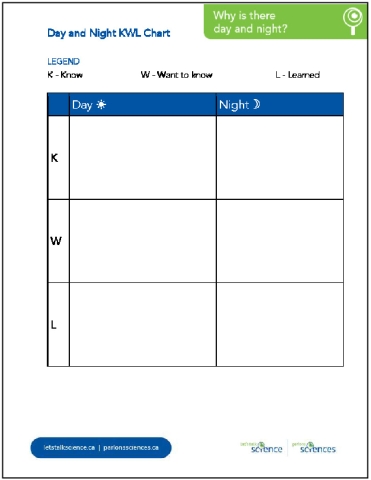
If you are unfamiliar with KWL charts, review this page that explains in detail how to use this learning strategy. Students may need further support for triggering their knowledge. You could do this by showing students a time lapse video of night and day time such as this video or this video. Alternatively, encourage students to go outside with their trusted adults in the evening and during the day to make some observations. |
DiscussionsDiscussion prompts can include:
|
Action: What Causes Night and Day (30-40 min.)
| Instructions | Teaching Tips |
|---|---|
|
Show students the slideshow Why is there day and night? [Google slides] [pptx] [PDF] 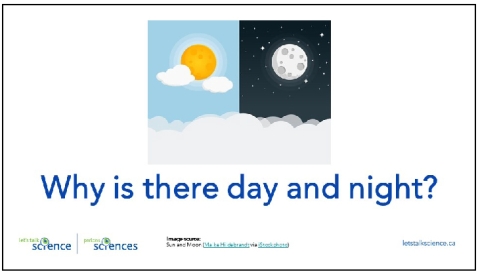
As a class add student questions and new knowledge and challenge existing ideas on the KWL chart. |
LanguageCreate a word wall with images of terminology students are likely to encounter during this lesson such as Sun, Moon, Earth, axis, turn, spin, etc. Incorporate vocabulary in other relevant languages as well (e.g., French). Ask students who feel comfortable sharing some of the words they know in the language they speak about night and day. |
|
Using a globe and a flashlight, demonstrate how the Sun shines on the Earth. You will want to do this in a somewhat darkened room. Encourage students to notice that only one side of the globe is lit by the flashlight. This is the part of the Earth that experiences day. The other side of the globe is in shadow. This is the part of the Earth that experiences night. Slowly turn to the globe to demonstrate how the Earth rotates like the animation in the slideshow. Note: To have students take notice of the rotation, put a sticker or marker on one spot on the globe. It could be where your school is located. Students should notice how different parts of the Earth pass through the light and shadow. Ask students if they think everyone around the world sees the Sun at the same time. Have them explain why or why not. Shine the light on Australia and ask if people on the opposite side can see the Sun. and ask them if it is night or day there. To see a demonstration on how to do this watch this video. |
IdeaIf you do not have access to a globe, you could use a foam ball with a wooden skewer pushed through the centre as an axis. DiscussionsDiscussion prompts can include:
|
Consolidation: Show What You Know (15-20 min.)
| Instructions | Teaching Tips |
|---|---|
|
Students could consolidate their learning about night and day by participating in the Why is there day and night? Consolidation activity [Google doc] [Word doc] [PDF]. 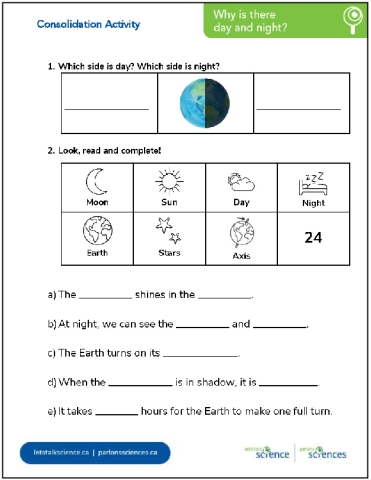
Use a projection device to share the page. You can read the sentences and students could select the correct word or image to fill in the missing word. Responses for the reproducible include:
If using the [Google jamboard] students can drag and drop the words into the correct places in the sentences. Make a copy of the jamboard before starting. 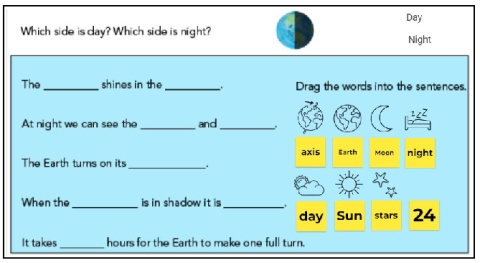
Alternatively, have a discussion with the class or with individual students using questions such as these:
|
LanguageIf you are using the reproducible on an interactive whiteboard, students could write or draw images to complete the sentences. |
|
As a class, using a projection device, reflect on the learning and contribute to the “L” section of the KWL chart. |
Background Information for Teachers
Why is there day and night?
Measuring time has been an important phenomenon for humans. Early people told time by watching shadows move across the land. Sundials were created in order to track this progression of shadows.
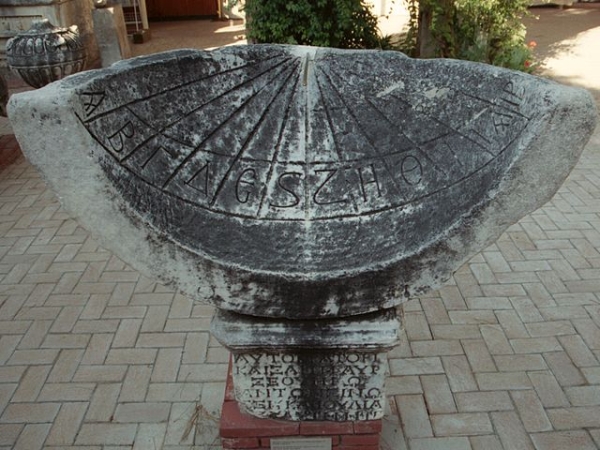
Sundial, 3rd century AD (Source: Zde [CC BY-SA via Wikimedia Commons).
Image - Text Version
Shown is a colour photograph of a concave piece of stone carved with radiating lines and symbols.
The stone is shaped like the peel from a slice of orange, or a shard of a broken bowl. It is thin and curved inward, facing up to the sky.
Inside the bowl are elaborate carvings. Straight lines radiate from the centre of the top edge, like bicycle spokes. Near the bottom edge, the space between each line is labelled with a symbol. These look like letters, but not from the English alphabet.
More letters are carved into the base holding the curved piece above the brick floor below. The whole structure is pale grey, shaded with black moss or grime. This is darkest in the carved lines.
The rotation of Earth on its axis is the reason why the Sun changes position in the sky over the course of the day. This rotation is measured by the 24 hour time system. People on different parts of the planet experience day and night at different times.
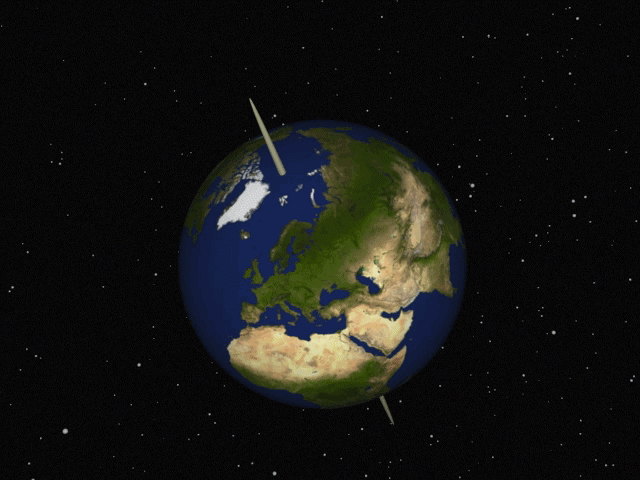 Animation of Earth spinning on its axis (Source: Silver Spoon [CC BY-SA 4.0] via Wikimedia Commons).
Animation of Earth spinning on its axis (Source: Silver Spoon [CC BY-SA 4.0] via Wikimedia Commons).
Image - Text Version
Shown is a colour animation of Earth rotating on what looks like a toothpick through its centre.
The Earth is spinning on its axis like a top. The axis is still, at the centre, while the rest of the Earth moves around it. It is represented by a long, thin stick that points up from the North Pole, and down through the South Pole.
This is tilted, so that the northern hemisphere is more visible than the southern hemisphere. In the background, space is black, dotted with white stars.
Additional Resources
Media
- Day and Night KWL Chart [Google doc] [Word doc] [PDF]
- Why is there day and night? Slideshow [Google slides] [pptx] [PDF]
- Why is there day and night? Consolidation [Google doc] [Word doc] [PDF] [Google jamboard]
Books
What Makes Day and Night by Franklyn M. Branley and Arthur Dorros.
A simple explanation of how the rotation of the earth causes night and day.
Read aloud version here.
ISBN 13 978-0062381972
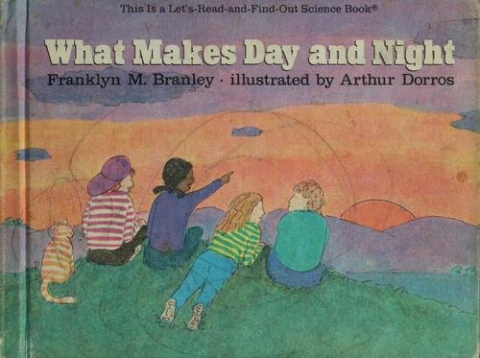
The Origin of Day and Night by Paula Ikuutaq Rumbolt and Lenny Lishchenko.
In this Inuit tale, the actions of a hare and a fox change the Arctic forever by creating day and night.
Read aloud version here.
ISBN 13 9781772271805
Community Connections
Encourage students to share the stories that have been shared with them that relate to the origin or cycle of day and night.
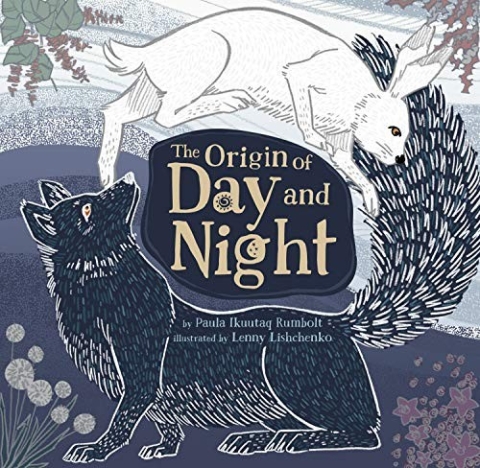
Videos
Day and night explanation causes science for kids (2019)
In this video (2:35 min.) Polly and Olly explain what causes day and night
Reproducibles and Media
Media
- Day and Night KWL Chart [Google doc] [Word doc] [PDF]
- Why is there day and night? Slideshow [Google slides] [pptx] [PDF]
- Why is there day and night? Consolidation [Google doc] [Word doc] [PDF] [Google jamboard]
Books
What Makes Day and Night by Franklyn M. Branley and Arthur Dorros.
A simple explanation of how the rotation of the earth causes night and day.
Read aloud version here.
ISBN 13 978-0062381972

The Origin of Day and Night by Paula Ikuutaq Rumbolt and Lenny Lishchenko.
In this Inuit tale, the actions of a hare and a fox change the Arctic forever by creating day and night.
Read aloud version here.
ISBN 13 9781772271805
Community Connections
Encourage students to share the stories that have been shared with them that relate to the origin or cycle of day and night.

Videos
Day and night explanation causes science for kids (2019)
In this video (2:35 min.) Polly and Olly explain what causes day and night
Science
- Making sundials is a great way to see how the Sun moves across the sky. At the beginning of the school day, with the students, set up an object that casts shadows and take photos once an hour in order to track how the Sun is moving.
Literacy
- Students could demonstrate an understanding of information and ideas by retelling how the movement of the Earth causes day and night to someone else.
- Build students’ online digital literacy skills by researching with them the concept of time zones. Talk about Canada’s different time zones and what time you should call family members who live in different parts of the country.
Mathematical Thinking
- Help students connect the location of the Sun with the time of day. This could be done in conjunction with making a sundial.
Visual Arts
- Students could make a painting about day and night.
- Students could talk about the colours they see in day and night ( cool and warm colours), bright and dark colours etc
Extensions
Science
- Making sundials is a great way to see how the Sun moves across the sky. At the beginning of the school day, with the students, set up an object that casts shadows and take photos once an hour in order to track how the Sun is moving.
Literacy
- Students could demonstrate an understanding of information and ideas by retelling how the movement of the Earth causes day and night to someone else.
- Build students’ online digital literacy skills by researching with them the concept of time zones. Talk about Canada’s different time zones and what time you should call family members who live in different parts of the country.
Mathematical Thinking
- Help students connect the location of the Sun with the time of day. This could be done in conjunction with making a sundial.
Visual Arts
- Students could make a painting about day and night.
- Students could talk about the colours they see in day and night ( cool and warm colours), bright and dark colours etc
If Sun Could Speak read by Author Kourtney Lafavre (2020)
This video (7:29 min.) from ClearFork Publishing is a read aloud of the entertaining and informative book about our largest star known as the Sun.
Sun: Sunset (Picture Collections)
Many people think the nicest time of day is when the sun is setting. Here are 5 images of scenes showing various sunsets.
Moon: Phases (Picture Collections)
Here are 8 images of different lunar phases showing the portion of the Moon lit by the Sun as the Moon orbits the Earth and as seen by us on Earth.
Learn More
If Sun Could Speak read by Author Kourtney Lafavre (2020)
This video (7:29 min.) from ClearFork Publishing is a read aloud of the entertaining and informative book about our largest star known as the Sun.
Sun: Sunset (Picture Collections)
Many people think the nicest time of day is when the sun is setting. Here are 5 images of scenes showing various sunsets.
Moon: Phases (Picture Collections)
Here are 8 images of different lunar phases showing the portion of the Moon lit by the Sun as the Moon orbits the Earth and as seen by us on Earth.
Media
- Day and Night KWL Chart [Google doc] [Word doc] [PDF]
- Why is there day and night? Slideshow [Google slides] [pptx] [PDF]
- Why is there day and night? Consolidation [Google doc] [Word doc] [PDF] [Google jamboard]
Books
What Makes Day and Night by Franklyn M. Branley and Arthur Dorros.
A simple explanation of how the rotation of the earth causes night and day.
Read aloud version here.
ISBN 13 978-0062381972

The Origin of Day and Night by Paula Ikuutaq Rumbolt and Lenny Lishchenko.
In this Inuit tale, the actions of a hare and a fox change the Arctic forever by creating day and night.
Read aloud version here.
ISBN 13 9781772271805
Community Connections
Encourage students to share the stories that have been shared with them that relate to the origin or cycle of day and night.

Videos
Day and night explanation causes science for kids (2019)
In this video (2:35 min.) Polly and Olly explain what causes day and night
Reproducibles and Media
Media
- Day and Night KWL Chart [Google doc] [Word doc] [PDF]
- Why is there day and night? Slideshow [Google slides] [pptx] [PDF]
- Why is there day and night? Consolidation [Google doc] [Word doc] [PDF] [Google jamboard]
Books
What Makes Day and Night by Franklyn M. Branley and Arthur Dorros.
A simple explanation of how the rotation of the earth causes night and day.
Read aloud version here.
ISBN 13 978-0062381972

The Origin of Day and Night by Paula Ikuutaq Rumbolt and Lenny Lishchenko.
In this Inuit tale, the actions of a hare and a fox change the Arctic forever by creating day and night.
Read aloud version here.
ISBN 13 9781772271805
Community Connections
Encourage students to share the stories that have been shared with them that relate to the origin or cycle of day and night.

Videos
Day and night explanation causes science for kids (2019)
In this video (2:35 min.) Polly and Olly explain what causes day and night
Science
- Making sundials is a great way to see how the Sun moves across the sky. At the beginning of the school day, with the students, set up an object that casts shadows and take photos once an hour in order to track how the Sun is moving.
Literacy
- Students could demonstrate an understanding of information and ideas by retelling how the movement of the Earth causes day and night to someone else.
- Build students’ online digital literacy skills by researching with them the concept of time zones. Talk about Canada’s different time zones and what time you should call family members who live in different parts of the country.
Mathematical Thinking
- Help students connect the location of the Sun with the time of day. This could be done in conjunction with making a sundial.
Visual Arts
- Students could make a painting about day and night.
- Students could talk about the colours they see in day and night ( cool and warm colours), bright and dark colours etc
Extensions
Science
- Making sundials is a great way to see how the Sun moves across the sky. At the beginning of the school day, with the students, set up an object that casts shadows and take photos once an hour in order to track how the Sun is moving.
Literacy
- Students could demonstrate an understanding of information and ideas by retelling how the movement of the Earth causes day and night to someone else.
- Build students’ online digital literacy skills by researching with them the concept of time zones. Talk about Canada’s different time zones and what time you should call family members who live in different parts of the country.
Mathematical Thinking
- Help students connect the location of the Sun with the time of day. This could be done in conjunction with making a sundial.
Visual Arts
- Students could make a painting about day and night.
- Students could talk about the colours they see in day and night ( cool and warm colours), bright and dark colours etc
If Sun Could Speak read by Author Kourtney Lafavre (2020)
This video (7:29 min.) from ClearFork Publishing is a read aloud of the entertaining and informative book about our largest star known as the Sun.
Sun: Sunset (Picture Collections)
Many people think the nicest time of day is when the sun is setting. Here are 5 images of scenes showing various sunsets.
Moon: Phases (Picture Collections)
Here are 8 images of different lunar phases showing the portion of the Moon lit by the Sun as the Moon orbits the Earth and as seen by us on Earth.
Learn More
If Sun Could Speak read by Author Kourtney Lafavre (2020)
This video (7:29 min.) from ClearFork Publishing is a read aloud of the entertaining and informative book about our largest star known as the Sun.
Sun: Sunset (Picture Collections)
Many people think the nicest time of day is when the sun is setting. Here are 5 images of scenes showing various sunsets.
Moon: Phases (Picture Collections)
Here are 8 images of different lunar phases showing the portion of the Moon lit by the Sun as the Moon orbits the Earth and as seen by us on Earth.